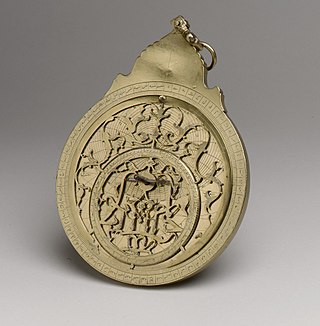
Brass is an alloy of copper (Cu) and zinc (Zn), in proportions which can be varied to achieve different colours and mechanical, electrical, acoustic, and chemical properties, but copper typically has the larger proportion. In use since prehistoric times, it is a substitutional alloy: atoms of the two constituents may replace each other within the same crystal structure.

Ore is natural rock or sediment that contains one or more valuable minerals concentrated above background levels, typically containing metals, that can be mined, treated and sold at a profit. The grade of ore refers to the concentration of the desired material it contains. The value of the metals or minerals a rock contains must be weighed against the cost of extraction to determine whether it is of sufficiently high grade to be worth mining and is therefore considered an ore. A complex ore is one containing more than one valuable mineral.

Smelting is a process of applying heat and a chemical reducing agent to an ore to extract a desired base metal product. It is a form of extractive metallurgy that is used to obtain many metals such as iron, copper, silver, tin, lead and zinc. Smelting uses heat and a chemical reducing agent to decompose the ore, driving off other elements as gases or slag and leaving the metal behind. The reducing agent is commonly a fossil fuel source of carbon, such as carbon monoxide from incomplete combustion of coke—or, in earlier times, of charcoal. The oxygen in the ore binds to carbon at high temperatures as the chemical potential energy of the bonds in carbon dioxide is lower than that of the bonds in the ore.

Zinc is a chemical element; it has symbol Zn and atomic number 30. It is a slightly brittle metal at room temperature and has a shiny-greyish appearance when oxidation is removed. It is the first element in group 12 (IIB) of the periodic table. In some respects, it is chemically similar to magnesium: both elements exhibit only one normal oxidation state (+2), and the Zn2+ and Mg2+ ions are of similar size. Zinc is the 24th most abundant element in Earth's crust and has five stable isotopes. The most common zinc ore is sphalerite (zinc blende), a zinc sulfide mineral. The largest workable lodes are in Australia, Asia, and the United States. Zinc is refined by froth flotation of the ore, roasting, and final extraction using electricity (electrowinning).

Chalcopyrite ( KAL-kə-PY-ryte, -koh-) is a copper iron sulfide mineral and the most abundant copper ore mineral. It has the chemical formula CuFeS2 and crystallizes in the tetragonal system. It has a brassy to golden yellow color and a hardness of 3.5 to 4 on the Mohs scale. Its streak is diagnostic as green-tinged black.

Sphalerite is a sulfide mineral with the chemical formula (Zn,Fe)S. It is the most important ore of zinc. Sphalerite is found in a variety of deposit types, but it is primarily in sedimentary exhalative, Mississippi-Valley type, and volcanogenic massive sulfide deposits. It is found in association with galena, chalcopyrite, pyrite, calcite, dolomite, quartz, rhodochrosite, and fluorite.

Adamite is a zinc arsenate hydroxide mineral, Zn2AsO4OH. It is a mineral that typically occurs in the oxidized or weathered zone above zinc ore occurrences. Pure adamite is colorless, but usually it possess yellow color due to Fe compounds admixture. Tints of green also occur and are connected with copper substitutions in the mineral structure. Olivenite is a copper arsenate that is isostructural with adamite and there is considerable substitution between zinc and copper resulting in an intermediate called cuproadamite. Zincolivenite is a recently discovered mineral being an intermediate mineral with formula CuZn(AsO4)(OH). Manganese, cobalt, and nickel also substitute in the structure. An analogous zinc phosphate, tarbuttite, is known.

Tetrahedrite is a copper antimony sulfosalt mineral with formula: (Cu,Fe)
12Sb
4S
13. It is the antimony endmember of the continuous solid solution series with arsenic-bearing tennantite. Pure endmembers of the series are seldom if ever seen in nature. Of the two, the antimony rich phase is more common. Other elements also substitute in the structure, most notably iron and zinc, along with less common silver, mercury and lead. Bismuth also substitutes for the antimony site and bismuthian tetrahedrite or annivite is a recognized variety. The related, silver dominant, mineral species freibergite, although rare, is notable in that it can contain up to 18% silver.

Stannite is a mineral, a sulfide of copper, iron, and tin, in the category of thiostannates.

Bournonite is a sulfosalt mineral species, trithioantimoniate of lead and copper with the formula PbCuSbS3.

Freibergite is a complex sulfosalt mineral of silver, copper, iron, antimony and arsenic with formula (Ag,Cu,Fe)12(Sb,As)4S13. It has cubic crystals and is formed in hydrothermal deposits. It forms one solid solution series with tetrahedrite and another with argentotennantite. Freibergite is an opaque, metallic steel grey to black and leaves a reddish-black streak. It has a Mohs hardness of 3.5 to 4.0 and a specific gravity of 4.85 to 5. It is typically massive to granular in habit with no cleavage and an irregular fracture.

Stephanite is a silver antimony sulfosalt mineral with formula: Ag5SbS4. It is composed of 68.8% silver, and sometimes is of importance as an ore of this metal.

Enargite is a copper arsenic sulfosalt mineral with formula Cu3AsS4. It takes its name from the Greek word enarge, "distinct". Enargite is a steel gray, blackish gray, to violet black mineral with metallic luster. It forms slender orthorhombic prisms as well as massive aggregates. It has a hardness of 3 and a specific gravity of 4.45.

Sulfosalt minerals are sulfide minerals with the general formula AmBnXp, where

Arsenical bronze is an alloy in which arsenic, as opposed to or in addition to tin or other constituent metals, is combined with copper to make bronze. The use of arsenic with copper, either as the secondary constituent or with another component such as tin, results in a stronger final product and better casting behavior.

A native metal is any metal that is found pure in its metallic form in nature. Metals that can be found as native deposits singly or in alloys include aluminium, antimony, arsenic, bismuth, cadmium, chromium, cobalt, indium, iron, manganese, molybdenum, nickel, niobium, rhenium, selenium, tantalum, tellurium, tin, titanium, tungsten, vanadium, and zinc, as well as the gold group and the platinum group. Among the alloys found in native state have been brass, bronze, pewter, German silver, osmiridium, electrum, white gold, silver-mercury amalgam, and gold-mercury amalgam.
Zinc smelting is the process of converting zinc concentrates into pure zinc. Zinc smelting has historically been more difficult than the smelting of other metals, e.g. iron, because in contrast, zinc has a low boiling point. At temperatures typically used for smelting metals, zinc is a gas that will escape from a furnace with the flue gas and be lost, unless specific measures are taken to prevent it.

Coloradoite, also known as mercury telluride (HgTe), is a rare telluride ore associated with metallic deposit. Gold usually occurs within tellurides, such as coloradoite, as a high-finess native metal.

Fahlore, or Fahlerz, refers to an ore consisting of complex sulfosalts, mostly the series between tennantite (Cu6[Cu42]As4S13 and tetrahedrite (Cu6[Cu42]Sb4S13. It comes from the German word for pale, fahl. This refers to the characteristic pale grey to dark black colour.

Arsendescloizite is a lead-zinc mineral, approved by the IMA in 1982. It is an arsenate analog of descloizite. Its first description was published in 1982.




















